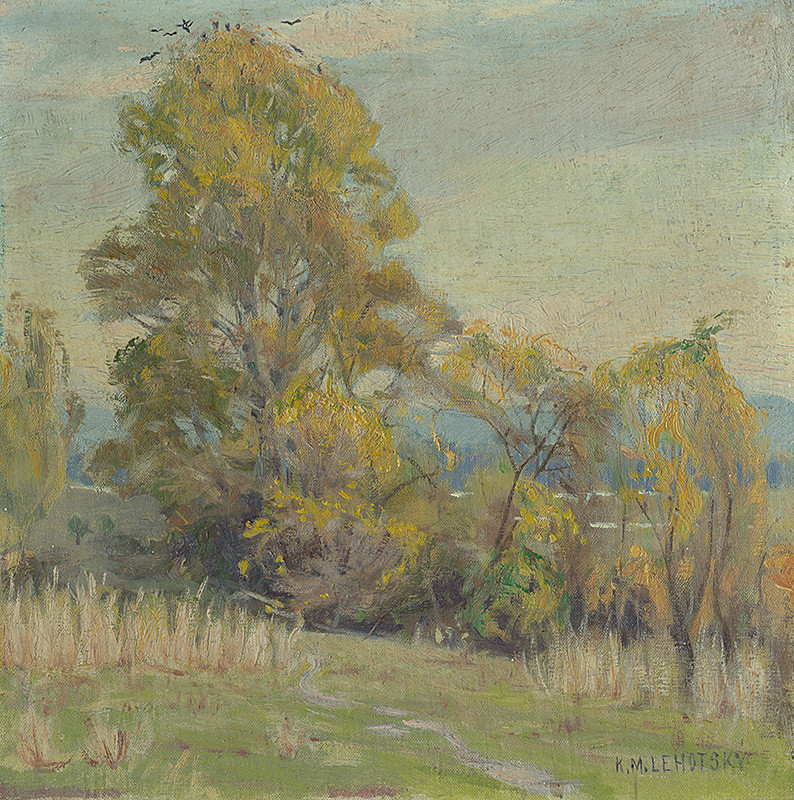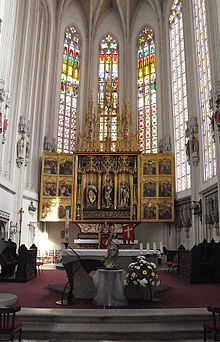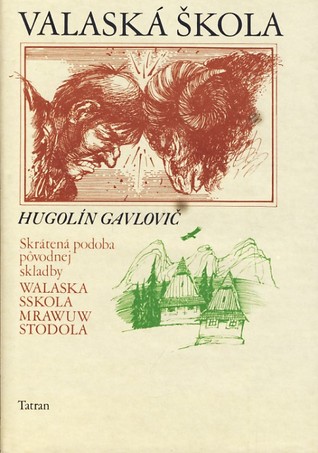Slovak art draws influences from many of the cultures around it. Many of its
artistic styles are similar to that of Germany, Austria, Hungary, Poland, and
Ukraine. In fact, Slovakia has taken quite a few measures toward preserving its
local folklore and folk art.
Wooden folk architecture can be seen throughout the country. One of the best
examples of this is in the village of Vlkolínec.
Even UNESCO has deemed it worthy of being a World Heritage Site. This village
stands out because its 45 log houses and churches have basically been preserved
this way since the 18th century. The completeness of this collection is what
makes this village extraordinary.
Visual art comes in all mediums from painting to photography to performance
art. The mega cathedrals, like St.
Elisabeth Cathedral in Košice,
were not only fantastic feats of architecture, but artists also contributed
their paintings and sculptures as well.
 |
| by Karol Miloslav Lehotský |
The Austro-Hungarian Empire formed in the late 1860s, and it was a time in
Slovakia where a lot of things were happening. However, it did spark a national
revival that showed up in their arts. Some of the important names to know from
this period include artists like Peter
Michal Bohúň (portraitist), Karol Miloslav Lehotský (landscapes), Maximilián Schurmann (impressionist), Vavrinec Dunajský and his son Ladislav
Dunajský (sculpture).
 |
| by Andy Warhol |
As European artists began to experiment with taking art to new levels in the
modern age of the 20th century, Slovak artists were right in the mix.
Symbolism, expressionism, art nouveau, graphic arts, print art, photography,
and pop art became wildly popular among artists. One of the most famous 20th
century artists ever was the iconic Andy
Warhol, known for his pop art and whose parents were immigrants from
Slovakia (he was born as Andrew Warhola). Some other artists of this period to
note include Mikuláš Galanda (one of
the pioneers of modern Slovak art), Blažej
Baláž (text as art), Koloman Sokol
(printmaker), Martin Martinček (photographer), Ján Koniarek (sculpture), among many
others.
 |
| An example of Old Church Slavic |
Slovak literature today is mainly written in the Slovak language. But we have Saints Cyril and Methodius to thank for
that. These two brothers, who were Byzantine Christian theologians, were tasked
with the project of translating the Bible and other religious texts into what
came to be known as Old Church Slavonic.
During the Middle Ages, most of the literature consisted of religious writings
mixed in with epic tales, folklore, and lyric poetry. Keep in mind that even
though written Slavic languages now were becoming a thing, Latin was still
heavily used (as well as some Czech), even as they moved into the Renaissance
period. The first printed book in Slovak ("The Book of Oaths" by Vašek Zaleský) was produced in 1561. A
definite division between religious and secular literature began to take place.
A good example of baroque literature is Hugolín
Gavlovič’s work Valašská škola,
mravúv stodola, which contained 17,862 verses.
The rise in literary nationalism after the French Revolution was felt in
Slovakia as well, and they followed in on the Classicism movement that was
sweeping Europe at the same time. The Slovak language was still being settled,
and much of it was more similar to Czech with a few key changes made to make it
a bit more like Slovak. Customization, if you will. But during this time it was
still part of the Kingdom of Hungary. The first Hungarian paper was published
in 1780, and the first Slovak one a few years later. Poetry was still going
strong during the mid-1800s when modern Slovak began to emerge. Janko Kráľ was one of the first poets
to publish works using this brand new modern Slovak form. During the
latter part of the 1800s when they were part of the Austro-Hungarian Empire,
poetry fell to the wayside in exchange for more literary realism in prose.
Things were changing quickly, and the political scene was driving toward chaos.
There were many writers writing in Hungarian, Czech, and Slovak during this
time.
The 20th century, and in particular, the years between the two world wars, brought a ton of changes to the country, and this showed in its literature. As the creation of Czechoslovakia came to be, there seemed to be two strains of literature: those of lyrical prose, and those of surrealism. For some reason, I wasn't able to find much on latter 20th century authors. I'm sure they're out there, though. Here are a few names I managed to come up with: Peter Pišťanek (known for his trilogy River of Babylon, The Wooden Village, and The End of Freddy), Juraj Červenák (novels and short stories, known for his historical fantasy and Slavic mythology), Juraj Kuniak (mostly known for poetry but had also published some prose), František Lipka (widely known as the diplomat who helped create Montenegro's independence, he's also a poet and translator), and Martin Rázus (poetry, drama, writer, but he was also a politician and Lutheran priest).
Up next: music and dance





No comments:
Post a Comment